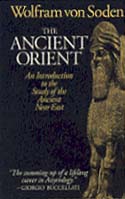The Ancient Orient: An Introduction to the Study of the Ancient Near East
Wolfram von Soden
(Grand Rapids, MI: Eerdmans Publishing Co., 1994) 262 pp., $14.99

Imagine writing the first comprehensive dictionary of a dead language, a three-volume work of over 1,500 pages. Then imagine writing countless articles and several other books on that language and culture. If you can picture all this, and if the language is Akkadian (the Semitic language of ancient Mesopotamia), then you are imagining Wolfram von Soden, the dean of Mesopotamian philology and professor emeritus at the University of Munster, Germany. In The Ancient Orient, a translation from the German, the Old Master has written a detailed and informative introduction to Mesopotamian culture.
It is amusing to note that von Soden defines the term “Ancient Orient” (and hence the scope of his book) as ancient Mesopotamia and its environs, to the exclusion of the Hittites, the Canaanites, the Israelites, the Egyptians and other inhabitants of the ancient Near East. There is a certain myopia here that reveals something of von Soden’s attitude towards his subject.
Von Soden surveys numerous aspects of Mesopotamian culture, including language, history, social institutions, agriculture, artisanry, commerce, law, science, religion and literature. These surveys sometimes seem choppy and impressionistic, but as a resource in English they fill an important gap. At times von Soden lapses into a lofty German professorial tone, as when he remarks that Babylonian mathematicians knew of “Pythagorean triplets” (whatever they are) or that “the history of the twenty-fourth century is in need of substantial correction,” or when he recommends topics for scholars to research, such as the husbandry of hogs.
Much of this book is directly relevant to our understanding of Israelite culture and religion. The sections on Mesopotamian practices and beliefs concerning the status of law codes, the role of the king, the types of cultic personnel, the nature of religious hymns and poetry, the role of women and many other matters enhance our understanding of comparable Israelite beliefs and institutions. For those who want an authoritative guide to ancient Mesopotamia, both for its own value and as a background for the Hebrew Bible, this is an illuminating book.
The Negev Project
Larry Witham
(College Park: Meridian Books, 1994) 301 pp., $17.95
Larry Witham’s The Negev Project begins and ends with a big bang. Within the novel, some of the scattered sparks from the cosmic explosion, as it were, come together in couples and artifacts united from around the world, but bombs shatter the dreams of love and wholeness along with a piece of ancient parchment—a telegram from the past.
There may be esoteric references throughout the book, but the story line does not bog down. By the end of page three, people have been shot in the head, customs inspectors are reaching for machine guns and attack dogs are biting men who then shoot them. You won’t be bored for lack of action. Against a backdrop of wars and fluctuating economies, the sale of antiquities is intertwined with international narcotics and arms traffic in the hands of Muslim extremists who seek to discredit the West for religious and political reasons.
The book’s global setting is appropriate to its theological overtones—from the traffic at Porta Sant’ Anna in Rome to the shops lining Dizengoff in Tel Aviv, from the tomato borsht in Leningrad to the academic infighting at Harvard University. The details of geography and demography are accurate. Good literature is layered, and Witham skillfully underscores theme with setting and symbol. This first novel is a structural masterpiece.
Readers of BAR will be tickled to encounter a likeness of editor Hershel Shanks in the editor of Bible Scholars Monthly, who bears Shanks’s initials in the novel. Harry Sloan, like Shanks in real life, had “taken on a crusading persona” and “led the fight to gain access to the unpublished Dead Sea Scrolls … Sloan’s magazine had flourished.” Like Shanks, Sloan is portrayed as a man “who chafed at the arrogance he had seen in the scholars who controlled the closed circle of scroll materials” and manages the media with consummate skill.
At the book’s dead center—nearly to the page—the protagonist speculates about Jesus as the “fulcrum” of the world, controlling what appears haphazard and mundane. “What and who was Jesus? Just human? God in man? What was Adam then?” The architecture of this novel, like the world it seeks to explain, is anything but accidental.
In today’s book market it is unusual to find an intelligent thriller that grapples with religious questions from the perspective of various faiths while addressing biblical scholarship, current events and international intrigue. Witham depicts academic conferences in California, factional rivalry in the Arab world and bureaucratic inertia in Russia. One hopes that the author, who normally works as a journalist, will follow this literary foray with more novels in the future.

